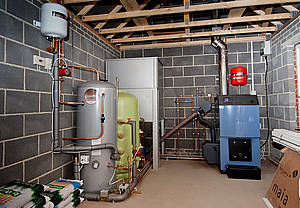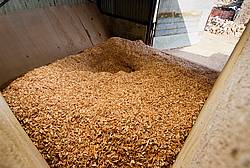A Perfect Alternative to LPG or Oil Boilers for Rural Customers
If you live somewhere without a natural gas connection you may be reliant on LPG or Oil heating systems. Biomass Boilers represent an affordable and sustainable alternative should you be faced with spiralling oil costs!
Traditional Logs
Traditional cut and dried logs are still widely used on the continent for heating. If you live in a remote area or have access to your own supply of timber it can make for a very attractive fuel source. Different species of wood burn differently, but providing the wood is seasoned and split the actual energy contained within is similar.
To burn efficiently the moisture content of the log fuel is important and adequate time must be allowed to season the wood. Once dry, the density of the wood will determine the energy content by volume and thus the size of the fuel storage area you will require.
Log burner systems are often simpler than pellet or chip fed systems because there is no fuel delivery mechanism, you simply open the door to the boiler and add the logs yourself! This can save on the installation costs due to the price of the selected boiler and, if you are prepared to fell and season the timber yourself can result in a very cost effective system.
Log burning boilers are typically manually fed, so require constant attention from the owner to ensure it is both fueled daily and cleaned regularly. They are not suitable for automated operation so if you are looking for a system requiring lower user intervention then wood pellets or wood chip may be a more suitable option.
Wood Pellets
Wood pellets are formed by tightly compacting sawdust and wood shavings from other parts of the lumber industry using similar equipment to that used to produce animal pellet feed. The resulting pellets are typically 6-8mm in diameter and between 20-30mm long, very hard but also very moisture absorbent. No synthetic chemicals or glues are used to bind the pellets together, the natural lignin in the wood is sufficient to hold the pellets in shape.
Due to the very low moisture content (MC) of the pellets if they are kept in a dry store they are less prone to clogging and fungal growth than wood chips, which typically contain more moisture. They burn very cleanly and are becoming more readily available from rural suppliers across the UK.
The design ideology behind the wood pellet boiler is one that is automatically fuelled from a large fuel store. The fuel store can be an off-the-shelf steel hopper, a Gore-Tex cloth and wooden frame bag style hopper, or even a custom built enclosure designed to fit within whatever space you have. Hoppers typically start at 1 tonne at the small domestic end, and scale up to practically any size you may require. Filling the hopper can be done manually as required on smaller systems, with anything upwards of 3 tonnes being filled via what is known as a "Blown Delivery" system, where a truck with a long flexible hose blasts new pellets into the fuel store using compressed air.
Pellets allow for a relatively low-interaction heating system, with the user required only to occasionally clean out ash, perform some basic checks on the health of the boiler and, of course, arrange for fuel deliveries when the store is running low! Due to the smaller size of the fuel stores required they can also fit within smaller domestic spaces, making them ideal should you live somewhere with no natural gas connection!
Wood Chips
Wood chips are, as you might expect, small pieces of wood typically 2-5cm long that have been partly seasoned to reduce the moisture content. Whilst they can be produced by the owner by means of a chipper and drier, they are more usually produced as a by-product of the forestry industry. When undertaking clearance work, or woodland thinning, young trees are removed and chipped to provide more space for the remaining trees to grow.
Wood chips contain more moisture and are less dense than pellets, resulting in a much larger storage area. Whilst the storage space required is larger, the cost per kW of generated heat is usually lower due to cheaper production overheads.
Due to their small size, wood chip can be fed from a fuel store to the boiler by means of a mechanical auger assembly which will continuously and automatically provide the correct level of fuel to the boiler. This allows them to run far more autonomously than log boilers, in a similar manner to pellet fuelled systems.
Small domestic systems generally require high quality chips with a lower range of moisture content, but should you be interested in producing your own wood chips from waste stock or felled timber solutions are available so just get in touch to discuss what's available.
Common Wood Fuel Characteristics
Different types of wood fuel contain, by volume, differing amounts of energy which is released when burned in a biomass boiler. The moisture content of the fuel along with the density of the fuel both affect how much energy is available per cubic meter. However, it is important to consider not just the absolute density, but the "Realistic" density of the fuel when it is stacked in your wood fuel store. As an example, pellets are very dense and, once loaded into the hopper, very little air is present per cubic metre. Stacked wooden logs however are very irregular in shape and also have a higher moisture content than pellets, meaning that whilst they release a lot of energy when burned, storing the equivalent amount of energy will take up more physical space. This can be an important consideration when choosing which type of fuel you would like to run the boiler from and detailed information is supplied below:
| Bulk Density kg per stacked or piled m3 | Density of Solids kg per solid m3 | Moisture Content Wet basis % | Calorific Value (net) MWhrs per solid m3 | Calorific Value (net) MWhrs per stacked m3 | Calorific Value (net) kWhrs per kg | |
|---|---|---|---|---|---|---|
| Unseasoned beech logs | 600-800 | 1000 | 50 | 2.1 | 1.5 | 2.1 |
| 2 Year air dried beech logs | 400-550 | 650 | 18-25 | 2.6 | 1.9 | 4.0 |
| Unseasoned conifer logs | 450-600 | 800 | 60 | 2.3 | 1.6 | 2.3 |
| 2 Year air dried conifer logs | 310-400 | 450 | 18-25 | 1.9 | 1.4 | 4.1 |
| Pellets | 600-800 | 1300 | 8-10 | 3.8 | 3.1 | 4.7 |
| Chips | 150-375 | 1000 | 20-30 | 2.3 | 1.0 | 3.6 |
Example Wood Fuel Costings
Below you can find the approximate costings for various fuel types to provide some insight into their relative expense in kWh when used for heating purposes.These prices are correct as of March 2012 and of course are subject to change based on wholesaler price changes and the cost of crude oil.
When considering costs when you look at the ever spiraling cost of electricity and gas as a home consumer, coupled with concerns over the global oil supply chain, locally sourced biomass fuels emerge as a stable and more predictable alternative!
| Fuel Type | £/tonne £/litre | Calorific Value (net) Per tonne / litre | pence/kWh |
|---|---|---|---|
| Electricity (Domestic) | 12.00 | ||
| LPG (Domestic) | 0.55 | 6.6 | 8.33 |
| Heating Oil (Domestic) | 0.65 | 10.3 | 6.30 |
| Heating Oil (Commercial) | 0.60 | 10.3 | 5.83 |
| Wood Pellet Bagged | 230 | 4800 | 4.79 |
| Wood Pellet (10% Moisture) | 220 | 4800 | 4.58 |
| Log Firewood | 150 | 3500 | 4.29 |
| Mains Gas (Domestic) | 3.50 | ||
| Wood Chip (20% Moisture) | 115 | 4100 | 2.93 |
| Wood Chip (30% Moisture) | 100 | 3500 | 2.86 |
| Mains Gas (Commercial) | 2.86 | ||
| Wood Chip (40% Moisture) | 80 | 2900 | 2.76 |
A Brief Costing Example
So now if we consider a large 5-bedroom domestic house, with a typical oil consumption for heating and hot water of 5000 litres. At a base cost (March 2012) of 62 pence per litre, we have an annual oil cost of £3,100. Running a 90% efficient biomass boiler, 20kW in size for 6 hours a day would yield an approximate fuel consumption of 10 tonnes of pellets per year. At a cost of £220 per tonne (March 2012), that represents an immediate saving of £900 per year. Add on top of this the commercial and domestic RHI payments, and the fact that in just 2 years the price of oil has risen by 50%, biomass represents a very attractive alternative!



